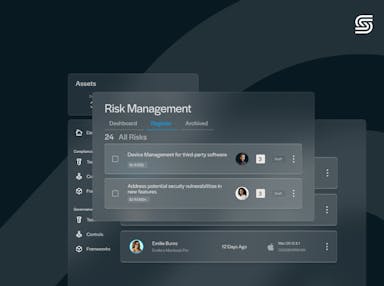
Compliance and Risk Management: Why Integrating Them Is Key to Protecting Your Organization
Anna Fitzgerald
Senior Content Marketing Manager
Cavan Leung
Senior Compliance Manager
Organizations today face a myriad of challenges related to regulatory requirements, industry standards, and emerging risks. To address these challenges, organizations must have robust compliance and risk management programs in place — and the more integrated, the better.
In this post, we'll explore the differences, similarities, and strategies for integrating compliance and risk management seamlessly into your business operations to help ensure the success and sustainability of your organization.
What is compliance management?
Compliance management refers to the process of ensuring that an organization adheres to relevant laws, regulations, standards, and internal policies. It involves:
- identifying and understanding what requirements are applicable
- establishing controls and procedures to meet those requirements
- monitoring these controls over time
- and addressing any non-compliance issues
Organizations that fail to maintain compliance may face regulatory fines, reputational damage, and legal action.
What is risk management?
Risk management, on the other hand, is the systematic process of identifying, assessing, prioritizing, and mitigating risks that could impact the achievement of organizational objectives. Risks can arise from various sources.
Common types of risks include:
- Strategic risks such as market competition and business model shifts
- Financial risks such as liquidity and investment losses)
- Legal risks such as lawsuits and regulatory penalties
- Operational risks such as supply chain disruptions and process failures
- Cybersecurity risks such as data breaches and ransomware attacks
- Compliance risks such as violations of regulations or failure to adhere to voluntary standards like SOC 2
Risk management involves:
- identifying all the types of risks that your organization is facing
- understanding the nature and magnitude of these different risks
- implementing measures to reduce their likelihood or impact
- and continuously monitoring and reviewing risk exposures
Effective risk management helps organizations proactively minimize threats and ensure long-term resilience.
Let’s take a closer look at the similarities between compliance and risk management below.
Recommended reading

What Is Risk Mitigation? + Strategies
What are the similarities between compliance and risk management?
Compliance and risk management share key similarities, including:
- Both functions involve the same core set of activities: risk assessments, policies and procedures, internal controls, documentation, and reporting.
- Both functions help management guide business operations and decision-making in order to achieve the company’s objectives.
- Both functions involve testing and monitoring to ensure effectiveness over time and continuous improvements.
- Both functions rely on security automation and AI and preventive measures to avoid incidents such as a data breach and ensure organizational integrity and resilience.
Despite these commonalities, compliance and risk management are not the same. Let’s take a closer look at their differences below.
Recommended reading

Risk and Compliance in the Age of AI: Challenges and Opportunities
What are the differences between compliance and risk management?
While they share similar purposes, compliance and risk management differ in their focus, scope, and approach in a number of ways. These differences are outlined in the table below.
| Compliance management | Risk management | |
| Focus | Primarily deals with meeting external requirements imposed by laws, regulations, standards, or customers. | Encompasses a broader spectrum of potential threats and uncertainties, including those arising from internal and external sources. |
| Scope | Scope is more limited to regulatory and contractual obligations. | Scope is broader to encompass all enterprise-wide risks, including compliance, operational, financial, and other types of risks. |
| Approach | Tends to be more prescriptive, with specific guidelines and regulations dictating required actions. | Involves more custom and strategic decision-making to anticipate and mitigate potential risks that are unique to the organization and its objectives. |
| Strategy | Often involves a reactive approach, with a focus on pursuing certifications and compliance after regulatory bodies or customers request it. | Emphasizes proactive identification and management of uncertainties to prevent adverse impacts on organizational objectives. |
Recommended reading

Regulatory Compliance Risk Management: Frameworks, Best Practices, & How to Do a Risk Assessment
Is compliance a subset of risk management or vice versa?
Compliance is an integral part of risk management since compliance risks can result in financial penalties, reputational damage, operational disruptions, loss of investors, loss of revenue, legal fees, and other severe consequences. However, compliance risk is just one type of risk organizations can face. Risk management is therefore a much broader area than compliance risk management.
While some experts in the compliance and risk management fields argue that compliance is a subset of risk management for this reason, the reverse can also be said to be true.
Effectively identifying, assessing, and mitigating risk is a critical requirement for achieving and maintaining compliance with frameworks such as SOC 2®, ISO 27001, PCI DSS, and HIPAA. However, organizations must implement additional controls and processes beyond risk management in order to comply with these information security frameworks. So risk management can also be seen as a subset of compliance management.
Both perspectives emphasize the same truth: risk management and compliance are inextricably linked. As a result, compliance and risk management functions should be integrated as much as possible in order to improve an organization’s stability and resiliency.

Before we look at how below, let’s explain how compliance and risk management can improve your organization’s stability and resiliency, among other benefits.
Why is compliance and risk management important?
Compliance and risk management are essential to building a resilient and trustworthy organization. By proactively addressing regulatory requirements and potential risks, businesses can protect their reputation, maintain strong relationships with stakeholders, and ensure long-term success. We’ll dive into some of these benefits below.
Protecting reputation and building trust
One of the most significant advantages of strong compliance and risk management programs is their ability to safeguard and enhance an organization’s reputation. Ethical business practices, regulatory adherence, and proactive risk management demonstrate a company’s commitment to information security and integrity.
This commitment fosters trust with customers, suppliers, investors, and regulators, which is crucial for long-term success. Organizations that fail to meet compliance requirements or effectively manage risks are more likely to experience security incidents, leading to reputational damage, customer churn, loss of business opportunities, and even legal repercussions.
Reducing financial losses and legal liabilities
Non-compliance with industry regulations and contractual obligations can result in hefty fines, legal action, and operational disruptions. Similarly, failing to manage risks—whether cybersecurity threats, financial uncertainties, or operational inefficiencies—can lead to costly incidents.
With strong compliance and risk management programs in place, organizations can identify potential compliance risks and other threats early, implement safeguards, and avoid fines and penalties that could harm profitability and stability.
Complying with regulations and industry standards
Having a compliance program can help organizations meet regulatory and customer requirements, avoid penalties, and demonstrate their commitment to ethical business practices. This adherence is particularly crucial in regulated industries like healthcare, finance, and technology, where failing to comply can lead to severe consequences.
Risk management strengthens compliance efforts by proactively identifying gaps that could lead to non-compliance. Instead of reacting to regulatory violations after they occur, businesses with strong risk management frameworks anticipate potential issues and take preventive action. This proactive approach not only reduces the likelihood of fines or legal repercussions but also fosters a culture of accountability and continuous improvement.
Gaining a competitive edge
Compliance helps businesses gain a competitive advantage by building trust and credibility in the marketplace. Organizations that demonstrate a strong commitment to compliance reassure customers, investors, and partners that they operate responsibly and securely. Meeting compliance requirements can also serve as a differentiator, particularly when competing for contracts or working with enterprise clients that prioritize security and regulatory adherence.
Risk management enhances this advantage by driving operational efficiency and resilience. A well-structured risk management program helps businesses identify inefficiencies, streamline processes, and mitigate potential disruptions before they impact operations. By minimizing risks and maintaining smooth business functions, organizations can focus on growth and innovation rather than constantly reacting to crises.
Enhancing incident detection and response
Risk management and compliance are not just about prevention—they also enable organizations to detect and respond to issues more effectively.
Compliance establishes guidelines for security controls, reporting requirements, and incident response protocols, ensuring organizations have clear procedures in place when incidents occur. Regulations like GDPR, HIPAA, and ISO 27001 mandate certain security measures and incident response plans, helping organizations minimize the impact of breaches or operational failures.
Organizations with strong risk management programs can also detect vulnerabilities earlier, implement stronger security measures, and respond to incidents with greater speed and efficiency. This proactive approach not only reduces downtime and financial losses but also reinforces stakeholder confidence.
Adapting to regulatory changes and emerging risks
The business environment is constantly evolving, with new regulations, cybersecurity threats, and economic uncertainties emerging regularly. Robust compliance and risk management programs can help ensure that organizations are prepared for these shifts. By continuously monitoring regulatory updates and assessing new risks, businesses can remain agile and resilient, adapting their strategies to maintain compliance while safeguarding their future.
Compliance and risk management each provide significant benefits on their own, but integrating them provides even greater benefits. Together, they enable businesses to maintain trust, avoid costly penalties, improve operational efficiency, and stay ahead of emerging risks—ultimately driving long-term success. Let’s go over how below.
Recommended reading

A Guide to Regulatory Change Management & How Software Can Simplify It
How to integrate risk management and compliance
Integrating risk management and compliance is essential for creating a robust and resilient governance framework that addresses both regulatory requirements and strategic objectives. Here are some tips to achieve this integration:
1. Align objectives
Ensure that risk management and compliance efforts are aligned with the organization's overall goals and objectives, taking into account both regulatory requirements and strategic priorities. For example, some goals or outcomes you aim to achieve through integrating compliance and risk management may be improving efficiency or enhancing risk awareness.
2. Focus on cross-department collaboration
Foster collaboration and communication between compliance and risk management functions to identify overlapping areas and streamline efforts. Establish clear roles and responsibilities and assign tasks and owners when possible to avoid duplicate work and ensure accountability.
3. Link controls and risks when possible
Some controls might be able to reduce compliance and other enterprise risks. In that case, compliance and risk management teams should collaborate when reviewing and remediating controls to ensure that the controls in place are effective and to reduce or avoid any duplicate controls and associated work.
4. Centralize third-party risk management
Compliance and risk management both require your organization to identify, assess, mitigate, and monitor any risks associated with your relationships with third parties. So it makes sense to consolidate all your third-party risk management efforts, processes, and data in one place like a GRC platform.
5. Embed risk and compliance into operations and decision-making
Embed risk management and compliance processes into existing business operations and decision-making frameworks. For example, consider embedding risk assessments and compliance activities into strategic planning, project management, and performance evaluation processes.
6. Leverage technology and automation
Utilize a governance, risk, and compliance (GRC) platform to streamline and automate compliance and risk management activities and track them all in one place. These tools can facilitate data sharing, reporting, and analysis, enabling more efficient and effective compliance and risk management.
Recommended reading

The Future of Risk Management: Embracing Automation for Better Decision-Making
How a GRC tool can help you integrate compliance and risk management
More than half of risk teams say they have seen “significant improvement” in how they manage risks by using applications such as advanced analytics, automated workflow solutions, artificial intelligence/machine learning, and GRC platforms.

A GRC platform can serve as a centralized hub for managing all aspects of compliance and risk management, providing features such as:
- Automated continuous monitoring: By continuously monitoring your security controls and risks, a GRC platform can help your organization proactively identify and respond to compliance issues and other emerging risks.
- Streamlined third-party risk management: A GRC tool can help you manage your entire third-party risk management program — including your policies and procedures, risk assessments, testing of controls, documentation, and any other due diligence activities — in a single, automated platform rather than a set of disparate tools. This makes it easier to build and maintain a secure and compliant third-party ecosystem.
- Workflow automation: A GRC tool can automate compliance and risk management processes, including risk assessments, remediation, and audit readiness, through automated workflows and task assignments, thereby reducing the time and resources required to manage each program.
- Reporting and analytics: GRC software can also generate comprehensive reports, analytics, and dashboards about your compliance status, risk exposures, and mitigation efforts. Centralizing this compliance and risk data in a single tool provides visibility into the overall effectiveness and efficiency of your organization’s compliance and risk management programs, where gaps exist, and what improvements you can make over time.
- Task tracking: A GRC tool also simplifies the analysis, tracking, and communication of tasks involved in assessing and managing risk and demonstrating compliance. Risk and compliance teams become more effective and efficient as a result, reducing the time and resources spent on managing disparate systems and processes.
- Mapping controls to risks: The best GRC tools will allow you to map controls to known risks so that you can coordinate your risk management strategies with your compliance requirements.
By leveraging GRC software, organizations can enhance their ability to integrate compliance and risk management efforts seamlessly, thereby strengthening their overall governance framework and resilience to emerging threats.
Recommended reading

How to Choose a GRC Software Solution
Why organizations choose Secureframe to integrate compliance and risk management
Organizations today are challenged with navigating the complexities of regulatory and customer requirements and emerging risks while achieving their strategic objectives.
Thousands of organizations have chosen Secureframe to address this challenge because of its automation and AI capabilities for compliance and risk management, including:
- End-to-end risk management: With Secureframe, organizations can assess and document treatment plans in their environment to meet the criteria for frameworks such as SOC 2, ISO 27001, PCI DSS, and HIPAA. Secureframe’s Risk Management system follows the ISO 27005 methodology so organizations can effectively assess risks in their environment to make smart decisions for their security compliance program.
- Control mapping to risks: Secureframe allows you to link controls to known risks so that you can coordinate your risk management strategies with your compliance requirements. Linking up controls helps organizations assess their residual risk so they can recognize and close any gaps in their risk management program.
- Automated control mapping suggestions: Comply AI for Control Mapping leverages advanced machine learning and natural language processing to intelligently suggest control mappings to risk assessments. This makes it even easier to link controls to risks in order to display the steps an organization has taken to mitigate risk and identify gaps so they can proactively treat and respond to risk.
- Task tracking and notifications: Organizations can create compliance and risk management tasks in the Secureframe platform, assign owners, set due dates, and send notifications via a preferred notification delivery method – email, Jira, or Slack. Tasks and notifications improve collaboration within your organization and ensure tasks are completed in a timely manner to maintain a strong risk and compliance posture.
- Centralized TPRM: Secureframe TPRM enables organizations to centralize and automate third-party review and risk management processes, including security reviews and continuous monitoring. This not only saves organizations time — it also helps them strengthen their ability to prevent third-party data breaches and maintain compliance.
To learn more about Secureframe or see these solutions in action, schedule a demo with our compliance experts today.
Use trust to accelerate growth
FAQs
What are the 5 key areas of compliance?
The five key areas of compliance typically include regulatory compliance, financial compliance, data privacy and security compliance, environmental compliance, and ethical standards and conduct.
What are the 4 pillars of risk management?
The four pillars of risk management are risk identification, risk assessment, risk mitigation, and risk monitoring and review. These pillars form the foundation of a comprehensive risk management framework aimed at addressing potential threats and uncertainties effectively.
What does compliance and risk management do?
Compliance ensures that an organization follows applicable laws, regulations, industry standards, and internal policies to help prevent legal violations, maintain ethical business practices, and build trust with stakeholders. Risk management is the process of identifying, assessing, and mitigating potential threats that could impact an organization's operations, finances, security, or reputation. It goes beyond regulatory framework requirements to proactively address internal and external vulnerabilities and uncertainties. Together, compliance and risk management help organizations operate securely, responsibly, and efficiently while minimizing legal, financial, and operational risks.
What is the difference between risk management and compliance management?
Compliance management focuses on ensuring that an organization meets legal, regulatory, and industry-specific requirements. Risk management, on the other hand, is a broader discipline that focuses on identifying, assessing, and mitigating all types of risks that could impact an organization’s objectives, from compliance to financial to operational to many types in between. Both are essential for building trust and proactively addressing threats, and integrating them leads to a stronger, more resilient business strategy.
How do risk and compliance work together?
Risk and compliance complement each other by ensuring that organizations not only follow regulations, laws, industry standards, and internal policies but also anticipate and mitigate potential threats beyond compliance risks. For example, compliance mandates that organizations implement cybersecurity controls to protect sensitive data. Risk management involves assessing how effective those controls are and identifying additional security measures needed to address evolving threats.
When integrated, compliance and risk management create a proactive and resilient organization that can adapt to regulatory changes and mitigate operational risks more effectively.
What’s the purpose of integrating compliance and risk management?
By aligning objectives, coordinating activities, integrating processes, and leveraging technology and automation across compliance and risk management functions, organizations can create a more resilient and efficient governance framework that enhances their ability to adapt and thrive in a dynamic business environment.
What is governance, risk, and compliance?
Governance, risk, and compliance (GRC) is a holistic approach to managing the interrelated aspects of organizational governance, risk management, and compliance with applicable laws, regulations, and standards.

Anna Fitzgerald
Senior Content Marketing Manager
Anna Fitzgerald is a digital and product marketing professional with nearly a decade of experience delivering high-quality content across highly regulated and technical industries, including healthcare, web development, and cybersecurity compliance. At Secureframe, she specializes in translating complex regulatory frameworks—such as CMMC, FedRAMP, NIST, and SOC 2—into practical resources that help organizations of all sizes and maturity levels meet evolving compliance requirements and improve their overall risk management strategy.

Cavan Leung
Senior Compliance Manager
Cavan Leung, CSSK, CISA, CISSP is an information security leader with over a decade of experience in the security, privacy, and compliance industries. A former auditor and security consultant, Cavan performed ERP and SOX compliance audits at Deloitte, as well as SOC 1, SOC 2, GDPR, and ISO 27001 compliance assessments for Fortune 500 companies at Schellman. At Secureframe, he’s helped hundreds of customers achieve compliance with SOC 2, ISO 27001, GDPR, HIPAA, and more.